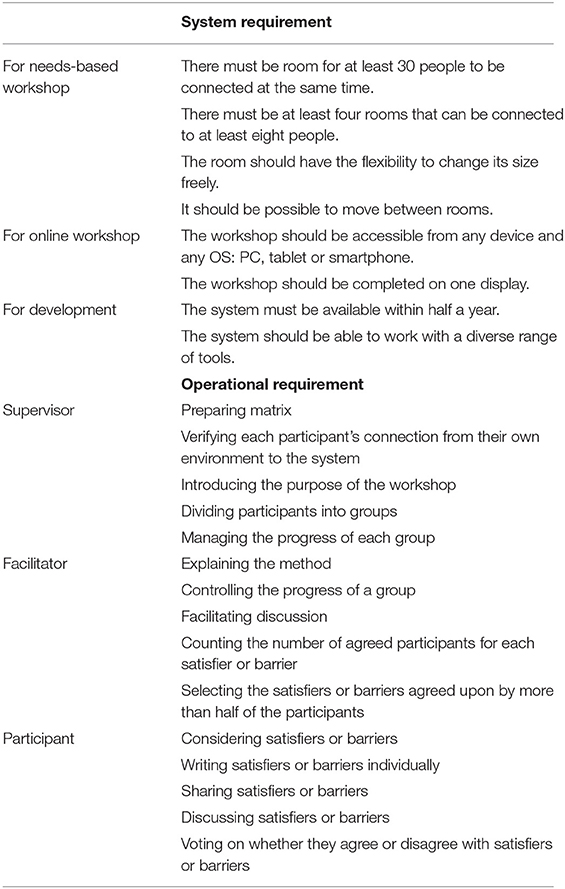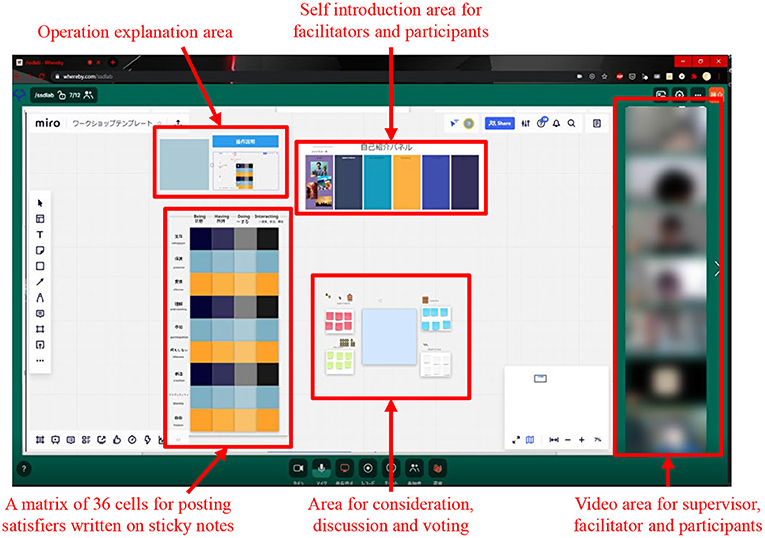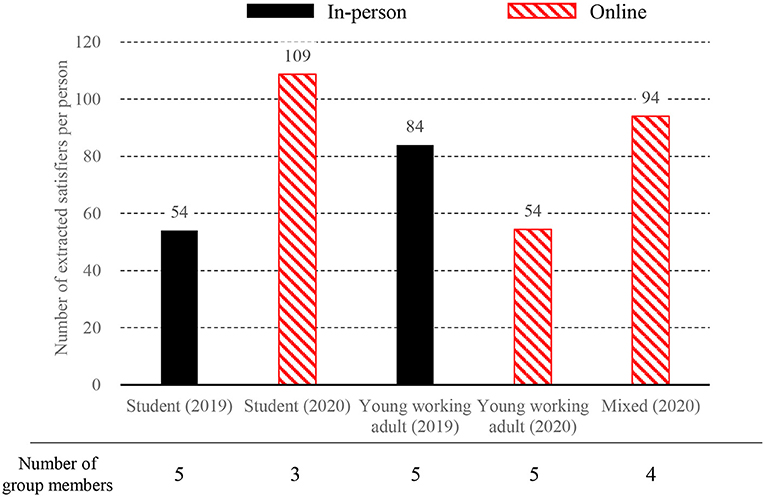- Graduate School of Engineering, Osaka University, Suita, Japan
The sustainable development goals, adopted in 2015, include achievement of sustainable consumption and production (SCP) patterns as the 12th goal. To achieve SCP patterns, it is necessary not only to reduce environmental load caused by production and manufacturing but also to improve the sufficiency of fundamental human needs and the quality of life of consumers. The living-sphere approach aims to design products for a target living sphere by determining the sufficiency of fundamental human needs among local residents through products using the fundamental human needs framework proposed by Max-Neef. This framework consists of fundamental human needs and satisfiers. Max-Neef argued that fundamental human needs are universal, but satisfiers fulfilling these fundamental human needs depend on region, culture and time. The satisfiers have previously been extracted by needs-based participatory workshops, but during the ongoing coronavirus disease 2019 (COVID-19) pandemic, these in-person workshops can no longer be held. In this study, we developed an online needs-based workshop (NBW) support system to replace the in-person NBW. The developed system consists of digital applications such as an online whiteboard service, video meeting service and original software to support facilitation. We applied the developed system to online NBWs held in Japan to verify the developed system and to validate whether the online NBW can replace the in-person NBW. The results verified that the developed system was working as designed. Comparison of the results between online and in-person sessions validated that replacing the in-person NBW with an online NBW using the developed system was highly possible.
Introduction
The sustainable development goals (SDGs) were adopted by all United Nations member states in 2015 as a universal call to action to end poverty, protect the planet and ensure that all people enjoy peace and prosperity by 2030 (UN, 2015). One of the goals is achieving sustainable consumption and production (SCP) patterns (UNEP, 2012). To achieve SCP patterns, it is necessary not only to reduce environmental load caused by production and manufacturing, but also to improve the sufficiency of fundamental human needs and the quality of life (QoL) of consumers. In other words, there is a need for new product design methods that consume less resources than previously, while improving the sufficiency of fundamental human needs.
Product design has traditionally been based on mass production and mass consumption such that products with almost the same function and structure have been manufactured and sold worldwide (Tseng et al., 1996). To reduce the environmental load of the product life cycle, eco-product design methods and methodologies have been developed (UNEP, 1997; ISO, 2002). Although there is a range of methods and methodologies in industrial countries, they mainly focus on reducing the environmental load of products and are less concerned with improving sufficiency.
Sufficiency is evaluated against various indexes. Subjective well-being is one of the indexes developed by the Organization for Economic Cooperation and Development and is evaluated through a questionnaire to determine whether people are satisfied with their daily life (OECD, 2013). This is a national scale index, but a human-scale index has also been proposed. Max-Neef claimed that the fundamental difference between needs and satisfiers of those needs is either not explicit or overlooked altogether, and that while fundamental human needs are universal, satisfiers fulfilling these basic needs depend on region, culture and period (Max-Neef, 1991). He proposed a fundamental human needs framework consisting of fundamental human needs and satisfiers. Here, fundamental human needs are the opposite of high-order needs and are synonymous with absolute or universal needs. However, the relationship between sufficiency and the product development process has not been clarified.
Kobayashi and Fukushige (2018) focused on the framework proposed by Max-Neef (1991) and proposed an approach to product design that improves the sufficiency of the target living sphere. This approach especially focuses on the relationship between products and satisfiers that have been extracted through needs-based workshops (NBWs) (Kobayashi et al., 2019). However, in-person workshops can no longer be conducted during the coronavirus disease 2019 (COVID-19) pandemic. COVID-19 has spread worldwide, and at the time of writing (March 18th, 2021), more than 120 million confirmed cases and more than 2.6 million deaths have been reported [see the World Health Organization (WHO) COVID-19 dashboard1]. Many countries have taken measures to slow the spread of the virus, such as restricting movement outside and inside the country, banning large gatherings and even imposing lockdowns in some areas (De Vos, 2020; Islam et al., 2020; Li et al., 2020). In this situation, there is an urgent need to develop a new NBW method that maintains social distancing and does not involve travel, if possible.
In this study, we developed an online NBW support system to replace the in-person NBW. This new system consists of digital applications such as an online whiteboard service, video meeting service and original software to support facilitation. We held online NBWs in Japan using this system to verify the developed system and to validate whether the online NBW can replace the in-person NBW by comparing results between online and in-person sessions.
This paper is organized as follows. In section Related Work, we review related works on human scale development, the living-sphere approach, NBWs and online workshops. Section Requirement Analysis for In-Person Needs-Based Workshop and System Development for Online Needs-Based Workshop outlines the online NBW support system that we developed based on requirement analysis, and section Case Study shows the results of online NBWs held in Osaka, Japan. Finally, section Comparison With In-Person Needs-Based Workshop concludes this paper.
Related Work
Human Scale Development
Human scale development (HSD) is an approach proposed by Chilean economist Manfred Max-Neef, and the purpose is to help groups or communities engage in the process of change and development (Max-Neef, 1991; Guillen-Royo, 2010). HSD is focused on and based on three pillars: (1) the satisfaction of fundamental human needs, (2) the generation of growing levels of self-reliance and (3) the construction of organic articulations of people with nature and technology, of global processes with local activity, of the personal with the social, of planning with autonomy and of civil society with the state.
In HSD, fundamental human needs are the same in all cultures and historical periods, changing only at a very slow pace according to our evolution as a species, and satisfiers are the values, attitudes, norms, laws, institutional arrangements, organizations, actions and ways of using spaces, resources and nature that define needs satisfaction in specific contexts and which vary across cultures and through time (Cruz et al., 2009; Guillen-Royo et al., 2017). Max-Neef organized fundamental human needs into two categories: axiological and existential. The axiological category includes subsistence, protection, affection, understanding, participation, idleness, creation, identity and freedom, and the existential category includes being, having, doing and interacting. Table 1 shows a matrix that overlays the axiological and existential categories, and the individual cells represent satisfiers. Max-Neef suggested five types of satisfiers for analytical purposes, namely, (a) violators or destroyers: elements of a paradoxical nature, (b) pseudo-satisfiers: elements that generate a false sense of satisfaction of a given need, (c) inhibiting satisfiers: those that generally oversatisfy a given need, and therefore seriously curtailing the possibility of satisfying other needs, (d) singular satisfiers: those that satisfy one particular need and (e) synergic satisfiers: those that satisfy a given need, while simultaneously stimulating and contributing to the fulfillment of other needs. He also proposed an NBW to construct a matrix containing destructive elements (negative satisfiers) affecting the participants' society but also a matrix of their utopia (positive satisfiers). Once the two lists have been drawn up, it is possible to design “bridges” enabling the participants to cross from an undesirable situation to a desirable one (Max-Neef, 1991; Jolibert et al., 2011).
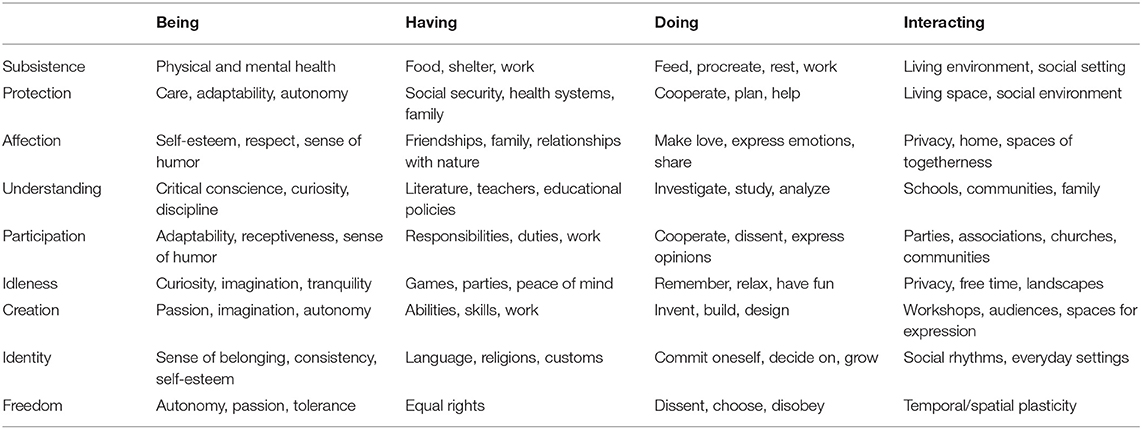
Table 1. Examples of satisfiers (Max-Neef, 1991).
Most HSD research is focused on only the consumption side of SCP (Max-Neef, 1991; Cuthill, 2003; Guillen-Royo, 2010, 2018; Guillen-Royo et al., 2017), but some studies apply the HSD framework to the production side. Vita et al. (2019) estimated the relationship between the needs satisfaction rate and the carbon footprint for 44 countries by linking economic goods and fundamental human needs using an input–output database. Brand-Correa et al. (2018) proposed an approach that enables local communities to propose alternatives to reduce energy use while maintaining human well-being by identifying links between energy services and fundamental human needs. These studies used only the concept of fundamental human needs to assess QoL and human well-being, and did not link the concept of satisfiers to products or services.
Living-Sphere Approach for Locally Oriented Sustainable Design
To achieve SCP patterns, it is necessary to both reduce environmental load caused by production and manufacturing, and improve the sufficiency of fundamental human needs and the QoL of consumers. Eco-product design methods and methodologies such as eco-design and design for sustainability (DfS) have been proposed to reduce the environmental impact of products throughout their entire life cycle (ISO, 2002; Dreyer et al., 2006; Spangenberg et al., 2010; UNEP, 2010; Arnette et al., 2014). However, these design methods and methodologies do not focus on improving the sufficiency of fundamental human needs and the QoL of consumers. This is despite the fact that sufficiency has been evaluated at the national level, such as the human development index established by the United Nations Development Programme and the subjective well-being index developed by the Organization for Economic Cooperation and Development (OECD, 2013; UNDP, 2015). However, it is difficult to apply these assessments to product design at manufacturing companies.
Kobayashi and Fukushige (2018) focused on the abovementioned framework proposed by Max-Neef and proposed an approach to product design that improves the sufficiency of the target living sphere by connecting a value graph of the product with the framework (Ishii, 1998). In this approach, it is assumed that fundamental human needs are fulfilled by activating the satisfiers proposed by Max-Neef (1991). Multi-products are connected to satisfiers in the framework of the living-sphere approach (Figure 1). Therefore, extracting adequate satisfiers is a key task in the living-sphere approach. In particular, because synergic satisfiers can satisfy multiple basic needs simultaneously, proposing a group of products in the living sphere that satisfies the synergic satisfiers may lead to the realization of a society with a high level of sufficiency with a minimal variety of products. In the living-sphere approach, satisfiers are extracted by NBWs. An example application based on the living-sphere approach is a proposed conceptual method of modeling the relationship between a product and satisfiers through the product's functions and requirements (Murata and Kobayashi, 2019).
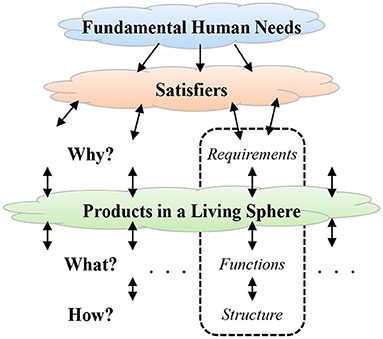
Figure 1. Concept of the living-sphere approach (Kobayashi and Fukushige, 2018).
Needs-Based Workshop
Max-Neef (1991) proposed a 2-day NBW attended by 50 people. Table 2 shows the phases of this workshop (Guillen-Royo, 2018). After completing all four phases, and if time allows, the participants are asked to produce a matrix of their utopia (satisfier matrix) by employing the same procedure as that for the construction of the barrier matrix. Once the two synthesis matrices are produced (barrier and satisfier), the participants are divided into groups to find the most synergic bridging satisfiers (those that would enable a society or community to transition from a situation dominated by harmful satisfiers to another characterized by synergic ones). An example of a workshop conducted according to these phases is one held in the Gold Coast, Australia (Cuthill, 2003). The workshop had two objectives: to facilitate a participative exercise of self-diagnosis involving representatives from diverse community-based sectors in the Gold Coast, and to seek baseline data on “causal” social factors behind community issues in the Gold Coast. The difference between this workshop and that proposed by Max-Neef is that each of the 9 groups filled one of the axiological needs in the matrix rather than the entire matrix.
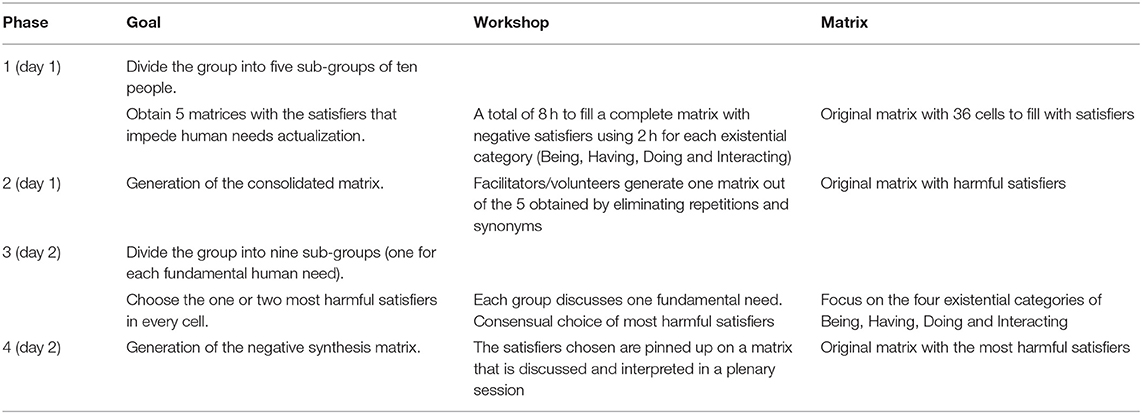
Table 2. Structure of needs-based workshop (Max-Neef, 1991; Guillen-Royo, 2018).
However, most recorded applications of the HSD matrix have not followed the phases recommended by Max-Neef because HSD-based research projects are typically initiated by researchers and not by grass-roots organizations or communities, and researchers have often had a limited amount of funding and time to allocate to the exercise, which has frequently limited the possibility of organizing workshops lasting several days (Guillen-Royo, 2018). In the literature, a matrix of human needs is commonly used as one of many tools in a research project and it elicits either barrier, synergic or synergic bridging satisfiers. For example, Guillen-Royo et al. (2017) reported on a workshop involving 16 unemployed participants in Granada, Spain. The workshop consisted of three phases: 3 h was spent on generating a barrier matrix by 8 people, 3 h on generating a satisfier matrix by 8 people, and 3 h on identifying synergic bridging satisfiers by 14 people. Guillen-Royo (2010) also reported on a workshop held in Lleida, Spain, with 47 people in their teens to 70s. The workshop involved ten 3-h discussion groups, with 5 to 12 participants in each group, and followed the same procedure as that of the workshop in Granada, Spain.
Another example is the workshop that Kobayashi et al. (2019) held in Hanoi, Vietnam. The purpose of their workshop was to identify and analyze satisfiers and barriers for young Vietnamese to realize SCP. Here, the barrier is a concept proposed by Kobayashi et al. (2019) that refers to a negative satisfier to avoid confusion with the positive satisfier. In the present paper, we also use this concept to avoid confusion. This workshop consisted of 4 groups of 5–6 people, with a total of 22 participants. This workshop differs from those of Guillen-Royo and Max-Neef in that either only satisfiers or barriers were extracted in each group, and synergic bridging satisfiers were not determined.
As shown above, past NBWs have been held in-person, but there are no reports on NBWs held during the COVID-19 pandemic. There are also no reports on online NBWs.
Online Workshop Support System
Collaborative work between distributed sites over the Internet has become important to companies and universities worldwide. However, as Marlow et al. (2016) found, current tools and approaches are inadequate for meeting scenarios that require participants to not only converse but also to share and co-reference different types of multimedia content across distances, and participants use a mixed set of tools to support different needs within different types of meetings because no single video conferencing tool includes sufficient functionality to address all their demands. Marlow et al. also argued that while collaboration tools might make it easier to use a combination of collaboration apps, they do not provide users with enough guidance for choosing among the tools in different circumstances, or for adapting the interface functionalities and presentations based on their goals and tasks.
Kaeri et al. (2020) proposed agent-based management of support systems for distributed brainstorming, focusing on system flexibility and usability. While there are various definitions of flexibility and usability, the present study focuses on the following definitions (Xavier et al., 2001; Gorod et al., 2008). Flexibility is defined as the ability of a system to respond to potential internal or external changes, affecting its value delivery, in a timely and cost-effective manner (Nilchiani and Hastings, 2007). Usability is defined as the ease of use and acceptability of a system for a particular class of users carrying out specific tasks in a specific environment (Holzinger, 2005). The system proposed by Kaeri et al., however, is designed specifically for brainstorming from the perspective of usability and flexibility, so it is difficult to apply to other workshops, including NBWs, in which the required functions vary greatly.
Requirement Analysis for In-Person Needs-Based Workshop and System Development for Online Needs-Based Workshop
Approach
Table 3 shows the differences between brainstorming and NBWs. Brainstorming helps all participants to diverge ideas through discussion on a given topic. It might also involve a process of convergence. However, an NBW extracts inherent and implicit satisfiers by individual consideration and group sharing. Therefore, in the present study, we developed an original support system to organize online NBWs.
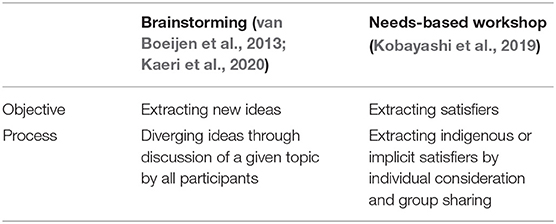
Table 3. Differences between brainstorming and needs-based workshops (van Boeijen et al., 2013; Kobayashi et al., 2019; Kaeri et al., 2020).
The system was developed based on systems engineering (Weilkiens, 2007). First, the requirements for the system to be developed (to-be system) were organized by analyzing the requirements of as-is systems such as in-person workshops and online workshops. Next, the requirements of the to-be system were classified into functions to be realized by the system and functions to be realized by operations. Finally, the functions that should be realized by the system were implemented in the system. The NBW method proposed by Kobayashi et al. (2019) was selected as the as-is in-person workshop in the present study.
Requirement Analysis for In-person Needs-Based Workshops
We conducted requirements analysis by analyzing procedures and NBW use cases. To analyze the procedures of these workshops, we used an activity diagram to visualize the processes carried out by stakeholders. Figure 2 shows an activity diagram of an in-person NBW.
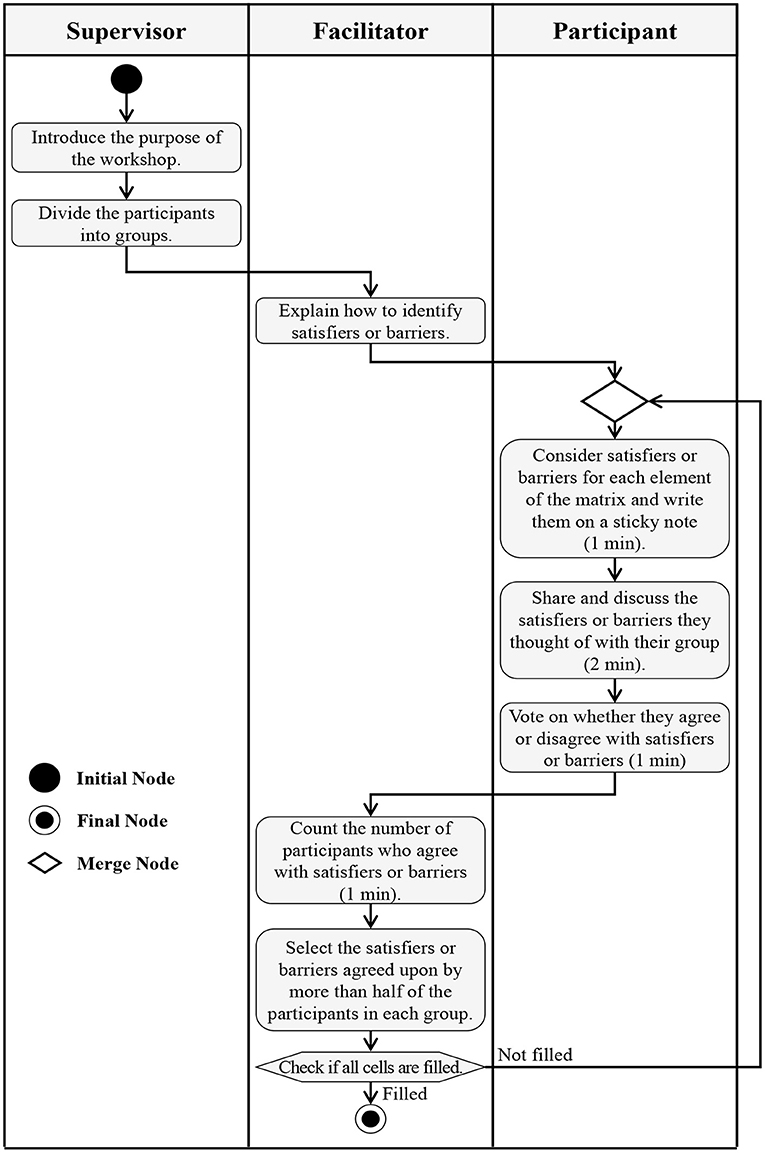
Figure 2. Activity diagram of an in-person NBW (Kobayashi et al., 2019). Activity starts at the initial node and ends at the final node. The merge node connects different flows.
Compared with the workshop method proposed by Max-Neef (1991), that proposed by Kobayashi et al. (2019) is unique in the following two points. One is that to fill each cell, participants have to consider satisfiers before the discussion process, and the other is that the synergic bridging satisfier is not extracted. The reason is that the workshop method proposed by Kobayashi et al. did not aim to share problems encountered by a group or community, but rather to apply them to product design, unlike in the case of HSD.
We used use case analysis to summarize the work done by each stakeholder within the NBWs. Table 4 shows the results of the use case analysis. The following requirements were identified in this analysis.
• Supervisor can prepare a room that the supervisors, the facilitator, and all participants can enter for the general explanation.
• Supervisor can provide multiple rooms for group work.
• Supervisor can prepare matrices of 36 squares, pens and sticky notes or alternatives for participants to write down satisfiers.
Requirement Analysis for Online Workshop
As mentioned in section Online Workshop Support System, online workshops require flexibility and usability. In this study, the following flexibility requirements were identified.
• Supervisor can change the number of people connected to each room.
• Supervisor can change procedures in NBWs (e.g., introduction process and procedure explaining process).
Usability analysis requires defining the users and the environment (Xavier et al., 2001). In this study, the users are assumed to be the supervisor, facilitator, and participants. The environment for the supervisor and facilitator should be a Windows PC prepared with a microphone and video. The facilitator should participate in separate locations from the supervisor and participants, or if the facilitator and supervisor are in the same room, they should maintain sufficient distance to avoid audio interference. The number of displays for the supervisor and facilitator should be sufficient to complete their tasks. Participants should be daily users of PCs and/or tablets. They should participate in the workshop from their own PC, tablet or smartphone. The PC operating system (OS) used by each stakeholder is assumed to be Microsoft Windows or Mac OS.
Based on the above definitions of users and environments, the following usability requirements were assumed.
• Workshop should be accessible from any device: PC with Microsoft Windows or Mac OS operating systems, tablet or smartphone.
• Workshop should be completed using one display.
System Implementation for Online Needs-Based Workshop
A summary of the requirements for the online NBWs is shown in Table 5. It was assumed that up to 4 groups would participate simultaneously, with 4–6 participants and 1 facilitator in each group, and 2–3 supervisors overall. In Table 5, we added a requirement for development speed because the workshops needed to be held within half a year to investigate changes in satisfiers over that period.
In order to meet the required development speed, we decided to use existing systems as much as possible. In particular, we considered flexibility and usability, and prioritized the use of existing cloud services. However, as mentioned by Marlow et al. (2016), it is difficult to satisfy these requirements in a single system.
Therefore, the system was developed by combining some suitable cloud services. The reason for choosing cloud services was to make the system accessible from any OS. These cloud services should have a public application programming interface (API) or built-in functions for integration with external services or software. In considering the requirements for flexibility, we distinguished the requirements to be realized by the system from those to be realized by the operations.
The aim of this distinction was to increase the reusability of the system by operationally realizing requirements that might change in the future.
We researched online communication tools and decided to base our system on Miro2, an online whiteboard service, and Whereby3, a video meeting service. Miro can be accessed by multiple people simultaneously, and because it is a cloud service, it can be accessed from any OS. Also, Miro's API is open to the public, so it can be easily linked with other services and additional systems can be developed. For the workshop, a supervisor can create and save a whiteboard to Miro's server and share its URL to allow multiple people to edit the content of the whiteboard.
Whereby is a cloud service that serves as a video meeting platform, and most importantly, it can integrate with Miro. This ability not only allows screen sharing of Miro whiteboards, but also enables users to embed Miro's applications in Whereby. This allows each participant to participate in video meetings while accessing Miro's whiteboard as individual users within a single screen. Figure 3 shows an example of the workshop screen.
However, the facilitator might be unable to accurately capture the status and progress of each participant using only audio and video information. In addition, it is difficult to facilitate and manage time at the same time in an online environment.
In order to simplify monitoring of the participants and time management, we developed a workshop status visualization system. This system has the following three functions: visualization of each participant's speech, visualization of the number of sticky notes used by each participant and visualization of the completion status of the matrix. This system is realized by combining Miro and “speech to text” via Miro's API. “Speech to text” is a service provided by Microsoft Azure that converts speech to text. Figure 4 shows an example screen of the status visualization system. The user interface allows 1 window per group, and if the supervisor manages 4 groups simultaneously, 4 windows are displayed. The online NBW support system that we developed is shown in Figure 5.
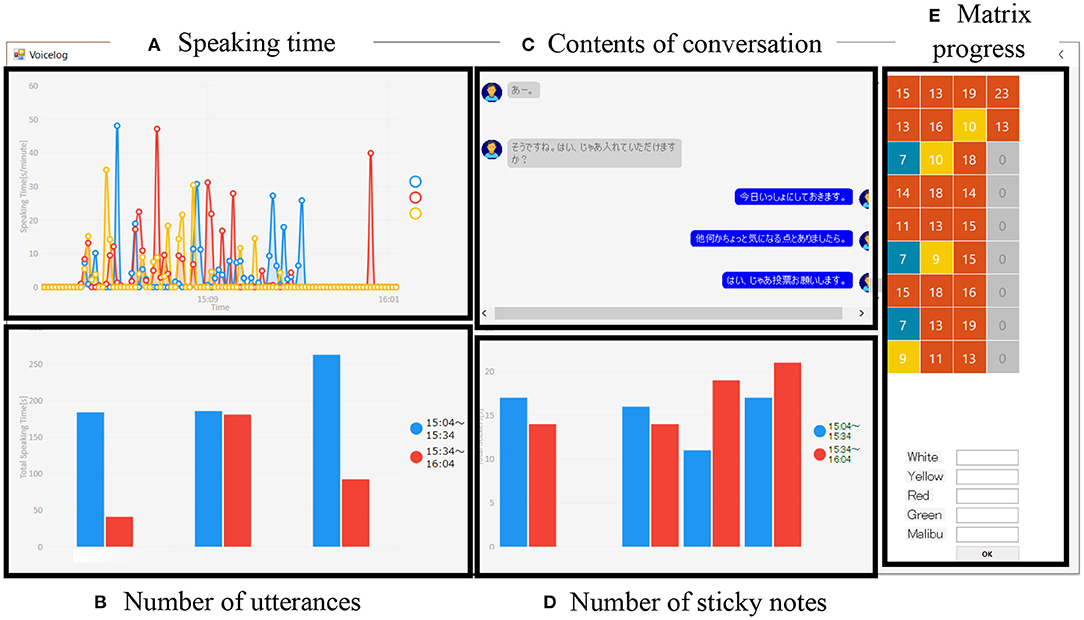
Figure 4. Example screenshot of a status visualization system. (A) Graph showing speaking time, with the number of utterances spoken in 1 min on the vertical axis, and the amount of elapsed time in the workshop on the horizontal axis. Each colored line represents a different participant. (B) Graph showing the total number of utterances spoken in 30 min. The blue and red bars indicate different 30-min periods. Each pair of blue and red bars shows the results for a single participant. (C) Contents of conversation between each participant and the facilitator. (D) Graph showing the number of sticky notes filled out in 30 min, with the blue and red bars indicating different 30 min periods. Each pair of blue and red bars represents a single participant's result. (E) Progress matrix (4 × 9) with each cell showing the number of sticky notes; the colors of the cells (gray, blue, yellow, and red) depend on the number of sticky notes.
Case Study
Location, Participants, and Procedure
To verify the developed system and to validate whether the online NBW can replace the in-person NBW, two online NBWs were held in Osaka, Japan. The first workshop was held in October 2020, and the second in December 2020. Participants were collected through online advertisements. The target of the advertisements was a maximum of 20 people aged between 18 and 40 years who were living within an 80-km radius from central Osaka. The advertisements also explained that participants would be paid an hourly wage. As a result, 8 people were recruited for participation in the first workshop and 4 in the second workshop.
The first workshop consisted of two groups: a student group consisting of 3 students and a young working adult group consisting of 5 workers. Initially, we had planned for a total of 4 groups: students' satisfiers, students' barriers, young working adults' satisfiers, and young working adults' barriers, but because only two groups were formed in the actual workshop, both groups extracted only satisfiers and not barriers. The second workshop consisted of a mixed group consisting of 1 student and 3 workers because there were not enough participants to justify two groups. The mixed group also extracted only satisfiers, and not barriers. The situation visualization system was not used in the first workshop due to the development progress, but only in the second workshop.
In terms of the workshop procedure, because of the need for online consideration, discussion and voting, a designated space was created on the online whiteboard. We also allocated additional time for connection checks for each participant before the workshop and an ice-breaker including self-introductions before the work began. A 15-min break was added to the end of each existential category, and a 1-h break was added to the end of two existential categories in consideration of fatigue caused by looking at the display for an extended period. In addition to the facilitator, we added an assistant to each group to manage the time and sticky notes. Also, the participants are asked to complete a feedback form after they completed both workshops.
Results and Discussion
One of the objectives of the workshops was to verify the developed system and to extract satisfiers. The results showed that the system worked as expected and satisfiers could be extracted as scheduled. To our surprise, most of the participants in the post-workshop feedback survey responded that the procedure was easy to understand (9 of 11 responses) and easy to operate (10 of 10 responses). The reason could be that most of the participants were familiar with video chat and online tools, especially considering that we collected participants through online advertisements only.
However, although the situation visualization system worked as planned, it did not produce the expected benefits. Table 6 shows the planned schedule vs. the actual times taken to complete each activity. As the table shows, time was not well-managed in extracting satisfiers in the mixed group, even though the situation visualization system was used. There are several possible reasons for this. One of the reasons is miscommunication between the supervisor and the facilitator, and another reason is that the facilitator was not used to controlling the discussion. Especially, as the participants get more excited during the discussion, control of the discussion tends to become more difficult. Currently, the facilitator decides how to control the discussion, but this might need to be documented in a manual. Meanwhile, an advantage of the online NBW is the status of the whiteboard and the amount of speech that can be visualized and converted into data. This information could be used to automate some of the tasks of the supervisor and facilitator in the future.

Table 6. Planned time schedule and the actual time spent on extracting satisfiers for each existential fundamental human need.
Table 7 shows the total and average number of extracted satisfiers in each group. Here, the number of extracted satisfiers refers to those before the vote, not to those that the majority of the participants agreed upon. Because the number of participants per group varied, we were concerned that groups with fewer participants would extract fewer satisfiers. However, as shown in Table 7, the average number of satisfiers extracted by the student group and that by the mixed group were almost the same, while the average by the young working adult group was half that of the other two groups. This difference might be due to some specific online problems such as difficulty in managing conversations with multiple participants at the same time and participant difficulty in handling the system, which needs to be analyzed in future studies.
Supplementary Tables A–C show the satisfiers that the majority of the participants in each group agreed upon. Supplementary Table A shows the results of the student group, Supplementary Table B shows the results of the young working adult group and Supplementary Table C shows the results of the mixed group. These results show that the synergic satisfiers in the student group were “affection,” “authority,” “belonging,” “creative,” “curious,” “discussing,” “free time,” “friend,” “interest,” “knowledge,” “making time,” “money,” “place with teacher,” “responsible for oneself,” “safe,” “sleeping” and “talking.” The synergic satisfiers in the young working adult group were “communication,” “consuming,” “diversity,” “interest,” “money,” “peaceful,” “respect,” “tolerance,” and “understanding each other.” The synergic satisfiers in the mixed group were “discussing,” “doing what makes us happy,” “fifty-fifty relationship,” “free time,” “house,” “imagination,” “motivation,” “partner,” and “safe living space.” Here, the synergy satisfiers were explored based on only word similarity, and semantic similarity was not taken into account. A synergic satisfier satisfies multiple fundamental human needs simultaneously, thus the product design that satisfies synergic satisfiers is required in the living-sphere approach. For example, “free time” satisfies affection, understanding, participation, idleness, creation and freedom in the student group, idleness in the young working group, and idleness, creation and freedom in the mixed group. Therefore, we can recognize that it is necessary to design products that can make daily work and transportation more efficient or automated.
These results also show that these satisfiers include almost no words related to COVID-19. Kobayashi et al. (2019) reported that satisfiers related to disasters that occurred in the same year were extracted in their workshop in Vietnam. In 2018, Vietnam experienced the worst-ever high-rise apartment fire in the county and many of the affected apartments were found to have poor fire protection systems. This event influenced the participants in the student group to extract “fire extinguisher” as a satisfier of protection. Considering the COVID-19 pandemic as similar to the disaster in Vietnam, it is expected that words related to COVID-19 will be extracted as satisfiers of protection, participation and freedom. For example, satisfiers such as “mask” and “avoiding crowds” could be extracted for protection, and satisfiers such as “going out” and “attending meetings” could be extracted for participation and freedom. These words, however, were not extracted as satisfiers, but rather “limited by law” and “restricted in activity” were extracted as satisfiers of freedom in the student group. This result indicates that participants in the student group may have regarded restrictions resulting from the spread of COVID-19 as freedom. However, because the online nature of the workshop may have prevented the use of words related to COVID-19, it is important to further analyze the results.
Comparison With In-Person Needs-Based Workshop
Results of the In-person Needs-Based Workshop
In 2019, an in-person workshop was held in Osaka, Japan. Participants aged between 18 and 40 years residing in and around Osaka were recruited through posters in public places, online advertisements and word of mouth. The workshop included two groups: two student groups consisting of 5 students each, and a young working adult group consisting of 5 workers. Supplementary Tables D–E show the satisfiers that the majority of the participants in each group agreed upon.
Comparison of the Results Between Online and In-person Sessions
Figure 6 compares the number of extracted satisfiers between the previous in-person workshops and the online NBWs. In the online NBWs, 109 satisfiers were extracted per person in the student group, 54 per person in the young working adult group and 94 per person in the mixed group. As mentioned above, all the groups in the in-person workshops consisted of 5 people. However, in the online workshops, the student group consisted of 3 people, the young working adult group consisted of 5 people, and the mixed group consisted of 4 people. The number of extracted satisfiers per person was highest in the 2020 student group, followed by the 2020 mixed group, then the 2019 young working adult group, and finally the 2019 student group and the 2020 young working adult group in equal numbers. In particular, the number of extracted satisfiers per person more than doubled when comparing those in the 2019 student group and the 2019 young working adult group with those of the 2020 student group. This indicates that the number of people in the group may affect the number of extracted satisfiers per person. Comparison between groups with the same number of participants showed that the 2020 young working adult group agreed upon the same number of satisfiers per person as the 2019 student group but agreed upon about 65% as many satisfiers per person as the 2019 young working adult group. This is likely due to differences among the participants themselves, but as mentioned in section Results and Discussion, it might also be due to the fact that the 2020 workshop was held online.
Next, we discuss the results of the qualitative analysis of the satisfiers extracted from the in-person and online NBWs. Here, it should be noted that satisfiers rely heavily on individuals and groups, and qualitative analysis depends on the subjectivity of the analyzer. Tables 8, 9 show a list of common satisfiers that satisfy the same fundamental human needs in multiple groups in 2020 and 2019. For example, “breathing” in Supplementary Tables A–C satisfies subsistence in the student group, the young working adult group and the mixed group. Common satisfiers were selected for qualitative analysis because of differences between individual participants and the groups.

Table 8. List of common satisfiers that satisfy the same fundamental human needs of multiple groups in 2020 (Satisfiers in underline were not extracted in 2019).

Table 9. List of common satisfiers that satisfy the same fundamental human needs of multiple groups in 2019 (Satisfiers in underline were not extracted in 2020).
Tables 8, 9 show that 65–100% of the common satisfiers of subsistence, understanding, idleness and creation in 2020 were also extracted in 2019, and vice versa. Meanwhile, <50% of the common satisfiers of affection and participation in 2020 are extracted in 2019, but more than half of the common satisfiers of affection and participation in 2019 were extracted in 2020. For protection, identity and freedom, there were few common satisfiers. Focusing on affection, “empathy” and “friend” were extracted in only 2019, while “hugging” and “loved” were extracted in only 2020. This may indicate that the participants in 2019 focused on objects of affection, while the participants in 2020 focused on behaviors they wanted. One of the reasons for this change is likely due to the impact of COVID-19, including restrictions on going out and decreased contact with others. For participation, there was a large increase in common satisfiers in 2020 compared with in 2019. Whereas, will for action was extracted as the common satisfier in 2019, how to take action was extracted more frequently in 2020. This change was partly due to the additional process of exploring available events to attend because events had been held on fixed dates and times until 2019, while events with large crowds were canceled in 2020. Another reason may be the widespread recognition that online meeting tools make communication with people in remote locations possible. The reason why there were few common satisfiers of protection and freedom may be that protection and freedom needs are rarely threatened in Japan. Subsistence needs are also rarely threatened in Japan, but there were more common satisfiers of subsistence than of protection and freedom, and their numbers were almost the same in 2019 and 2020. The reason for this may be that most of the satisfiers of subsistence were extracted as biologically essential for survival. The main reason why there were so few or no common satisfiers of identity is that there is no concept of identity itself in Japan, and no appropriate Japanese translation. The qualitative analysis results show that online NBWs can qualitatively replace in-person NBWs, but it should be noted again that this analysis is based on the subjectivity of the analyzer.
The results show that, even during the COVID-19 pandemic, it was possible to extract satisfiers from the target region through online NBWs using the developed system. It was also confirmed that synergic satisfiers were also extracted from the results of the online NBW. This could contribute to the design of locally oriented products that improve the sufficiency of the target region during the pandemic by following the living area approach. In addition, as the NBW moves online, geographic and time constraints are no longer concerns, which opens the possibility of extracting satisfiers from more regions. In the future, anyone will be able to run an online NBW by following a manual that provides guidance on the system and workshop procedure, which could be a great contribution to HSD.
Conclusion
In this study, we developed a new online NBW support system by combining an online whiteboard service, video meeting service and our own workshop situation visualization system in order to address the difficulty of holding in-person workshops due to the ongoing COVID-19 pandemic. Through the online NBWs held in Osaka, Japan, we verified the developed system and validated that the online NBW could replace the in-person NBW. The results of the online NBWs verified that the developed system was working as designed. The results of quantitative and qualitative analysis of past in-person NBWs and online NBWs showed no significant change in the quality of the extracted satisfiers, although further quantitative analysis of the number of extracted satisfiers is necessary. Therefore, we conclude that replacing the in-person NBW with an online NBW using the developed system is highly possible.
Some issues remain to be resolved in this study. The first is the environment of the supervisor, facilitator and participants. The development system assumed that the facilitator and supervisor would be able to join from an ideal environment, and that the participants would access the workshops with sufficient Internet connection speed and an information and communication technology (ICT) device meeting certain specifications. In practice, there were no such problems in the online workshops held in Osaka, Japan. However, even in Japan, people in rural areas might use legacy ICT devices and do not have a well-established network infrastructure. The same problem is expected to occur in regions outside Japan. The other issue was the age of the participants. The participants in this study were expected to be aged 18–40 years and likely familiar with handling ICT devices. However, we have previously held NBWs for older adults aged over 65 years, and such participants might not own or have access to an ICT device. Even if they do own ICT devices, they might not be able to handle the devices well enough to fully participate in the workshops. It is necessary to consider how we can run workshops other than in-person for participants who are unable to join from an appropriate environment and those who are not familiar with handling ICT devices.
In the future, we hope to conduct online NBWs with more simultaneous groups to extract both satisfiers and barriers, and to hold online NBWs in countries other than Japan. We also hope to contribute to improving regional SCP by developing a methodology to utilize the extracted satisfiers in product design.
Data Availability Statement
The original contributions presented in the study are included in the article/Supplementary Material, further inquiries can be directed to the corresponding author/s.
Author Contributions
HM managed the research and wrote the paper. SH developed the system. HK supervised from the perspective of the living-sphere approach. All authors contributed to the article and approved the submitted version.
Funding
This research was supported by the Environment Research and Technology Development of Fund (S-16-1, JPMEERF16S11610).
Conflict of Interest
The authors declare that the research was conducted in the absence of any commercial or financial relationships that could be construed as a potential conflict of interest.
Publisher's Note
All claims expressed in this article are solely those of the authors and do not necessarily represent those of their affiliated organizations, or those of the publisher, the editors and the reviewers. Any product that may be evaluated in this article, or claim that may be made by its manufacturer, is not guaranteed or endorsed by the publisher.
Supplementary Material
The Supplementary Material for this article can be found online at: https://www.frontiersin.org/articles/10.3389/frsus.2021.687754/full#supplementary-material
Footnotes
References
Arnette, A., Brewer, B., and Choal, T. (2014). Design for sustainability (DFS): the intersection of supply chain and environment. J. Clean. Prod. 83, 374–390 doi: 10.1016/j.jclepro.2014.07.021
Brand-Correa, L.I., Martin-Ortega, J., and Steinberger, J.K. (2018). Human scale energy services: untangling a ‘golden thread'. Energy Res. Soc. Sci. 38, 178–187. doi: 10.1016/j.erss.2018.01.008
Cruz, I., Stahel, A., and Max-Neef, M. (2009). Towards a systemic development approach: building on the human-scale development paradigm. Ecol. Econ. 68, 2021–2030. doi: 10.1016/j.ecolecon.2009.02.004
Cuthill, M. (2003). From here to Utopia: running a human-scale development workshop on the Gold Coast, Australia. Local Environ. 8, 471–485. doi: 10.1080/13549830306666
De Vos, J. (2020). The effect of COVID-19 and subsequent social distancing on travel behavior. Transport Res Interdiscip Perspect. 5, 1–3. doi: 10.1016/j.trip.2020.100121
Dreyer, L., Hauschild, M., and Schierbeck, J. (2006). A framework for social life cycle assessment. Int. J. LCA. 11, 88–97.
Gorod, A., Jimmy, S., Sauser, B., and Boardman, J. (2008). Flexibility of system of systems. Global J Flexible Syst Manage. 9, 21–31. doi: 10.1007/BF03396548
Guillen-Royo, M. (2010). Realising the ‘wellbeing dividend': an exploratory study using the human scale development approach. Ecol Econ. 70, 384–393. doi: 10.1016/j.ecolecon.2010.09.010
Guillen-Royo, M., Guardiola, J., and Garcia-Quero, F. (2017). Sustainable development in times of economic crisis: a needs-based illustration from Granada (Spain). J. Clean. Prod. 150, 267–276. doi: 10.1016/j.jclepro.2017.03.008
Holzinger, A. (2005). Usability engineering methods for software developers. Commun. ACM 48, 71–74. doi: 10.1145/1039539.1039541
Ishii, K. (1998). Textbook of ME217 Design for Manufacture: Product Definition. Geneva: Stanford University.
Islam, N., Sharp, S. J., Chowell, G., Shabnam, S., Kawachi, I., Lacey, B., et al. (2020). Physical distancing interventions and incidence of coronavirus disease 2019: natural experiment in 149 countries. BMJ 370, 1–10. doi: 10.1136/bmj.m2743
ISO (2002). ISO/TR 14062 Environmental Management - Integrating Environmental Aspects Into Product Design and Development. ISO.
Jolibert, C., Max-Neef, M., Rauschmayer, F., and Paavola, J. (2011). Should we care about the needs of non-humans? Needs assessment: a tool for environmental conflict resolution and sustainable organization of living beings. Environ. Policy Govern. 21, 259–269. doi: 10.1002/eet.578
Kaeri, Y., Sugawara, K., Moulin, C., and Gidel, T. (2020). Agent-based management of support systems for distributed brainstorming. Adv. Eng. Inform. 44, 1–13. doi: 10.1016/j.aei.2020.101050
Kobayashi, H., and Fukushige, S. (2018). A living-sphere approach for locally oriented sustainable design. J. Remanufact. 8, 103–113. doi: 10.1007/s13243-018-0048-8
Kobayashi, H., Sumimura, Y., Dinh, C. N., Tran, M., Murata, H., and Fukushige, S. (2019). Needs-based workshops for sustainable consumption and production in Vietnam. Smart Innovat. Syst. Technol. 155, 35–47. doi: 10.1007/978-981-13-9271-9_4
Li, Y., Campbell, H., Kulkarni, D., Harpur, A., Nundy, M., Wang, X., et al. (2020). The temporal association of introducing and lifting non-pharmaceutical interventions with the time-varying reproduction number (R) of SARS-CoV-2: a modelling study across 131 countries. Lancet Infect. Dis. 21, 193–202. doi: 10.1016/S1473-3099(20)30785-4
Marlow, J., Carter, S., Good, N., and Chen, J. (2016). “Beyond talking heads: multimedia artifact creation, use, and sharing in distributed meetings,” in Proceedings of the ACM Conference on Computer Supported Cooperative Work, 1703–1715.
Murata, H., and Kobayashi, H. (2019). “Proposal of a connecting method between product structures and fundamental human needs,” in Proceedings of the 11th International Symposium on Environmentally Conscious Design and Inverse Manufacturing.
Nilchiani, R., and Hastings, D. (2007). Measuring the value of flexibility in space systems: a six-element framework. Syst. Eng. 10, 26–44. doi: 10.1002/sys.20062
Spangenberg, J., Fuad-Luke, A., and Blincoe, K. (2010). Design for Sustainability (DfS): the interface of sustainable production and consumption. J. Clean. Prod. 18, 1485–1493. doi: 10.1016/j.jclepro.2010.06.002
Tseng, M., Jiao, J., and Merchant, M. E. (1996). Design for mass customization. CIRP Ann. 45, 153–156. doi: 10.1016/S0007-8506(07)63036-4
UN (2015). Sustainable Development Goals. Available online at: https://www.un.org/sustainabledevelopment/sustainable-development-goals/ (accessed March 10, 2021).
UNEP (1997). Ecodesign – A Promissing Apporach to Sustainable Production and Consumption. Hertfordshire: UNEP.
UNEP (2010). ABC of SCP – Clarifying Concepts on Sustainable Consumption and Production. Nairobi: UNEP.
van Boeijen, A., Daalhuizen, J., van der Schoor, R., and Zijlstra, J. (2013). Delft Sesign Guide: Design Strategies and Methods. Delft: Delft University of Technology.
Vita, G., Hertwich, G. E., Stadler, K., and Wood, R. (2019). Connecting global emissions to fundamental human needs and their satisfaction. Environ. Res. Lett. 14, 1–16.
Keywords: living-sphere approach, fundamental human needs, satisfier, online workshop, needs-based workshop
Citation: Murata H, Horio S and Kobayashi H (2021) Development of Online Needs-Based Workshop Support System in a Pandemic. Front. Sustain. 2:687754. doi: 10.3389/frsus.2021.687754
Received: 30 March 2021; Accepted: 05 July 2021;
Published: 03 August 2021.
Edited by:
Jussi I. Kantola, University of Turku, FinlandReviewed by:
Mario Fargnoli, Sapienza University of Rome, ItalyTomohiko Sakao, Linköping University, Sweden
Copyright © 2021 Murata, Horio and Kobayashi. This is an open-access article distributed under the terms of the Creative Commons Attribution License (CC BY). The use, distribution or reproduction in other forums is permitted, provided the original author(s) and the copyright owner(s) are credited and that the original publication in this journal is cited, in accordance with accepted academic practice. No use, distribution or reproduction is permitted which does not comply with these terms.
*Correspondence: Hidenori Murata, bXVyYXRhQG1lY2guZW5nLm9zYWthLXUuYWMuanA=
 Hidenori Murata
Hidenori Murata Seisuke Horio
Seisuke Horio Hideki Kobayashi
Hideki Kobayashi
